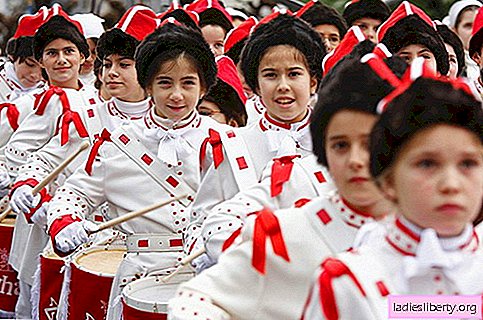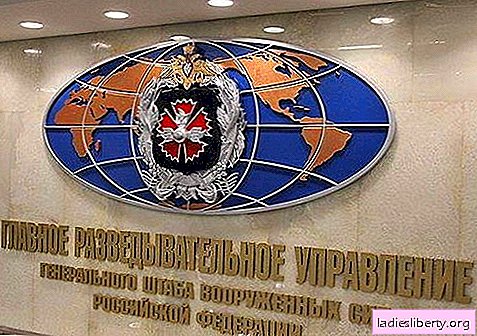
Holidays January 20
Tamborrada in San Sebastian (Spain)
This holiday is celebrated annually. Translated, its name sounds like "Drum." This is the day of drummers and many different percussion instruments. This holiday in San Sebastian is timed to the city patron Saint Sebastian. If we talk about versions of the origin of this holiday, then there are a great many different options. The most popular of them have their roots since Napoleonic times. It was then that the brave detachments of the army of Napoleon traveled through the city, which was under siege. The passage was forwarded by drumming. The army received an answer in the form of sounds made by drummers, striking their barrels. As a result of this, it was formed that two groups of drummers take part in the festival, one is represented by the Napoleonic army in appropriate costumes, and the second group is cooks and water carriers. The beginning of the holiday begins to mark at exactly midnight. At this time, the city flag is raised on the main square. This action is usually performed to the sounds of a solemn march played by musicians. The following are a variety of compositions. City processions take place all day, in which mummers take part who play drums or barrels. All this ceremony is accompanied by a brass band. In the morning on the streets of the city is a children's parade. At the head of the parade is a general who is being elected on the spot with his assistants. A special role is given to Beauty Easo. This nickname is unofficially called San Sebastian. With the beauty follow maids of honor. At this holiday, awards are presented to citizens and organizations. Awarding takes place in the city hall. After all this, all people come to the city square and enjoy listening to a number of drum marches.
Spouse's Day in Iceland
On this day, according to the Old Icelandic calendar, an angry winter month begins, called Torrey. In different Icelandic districts, there are different customs about who the husband or wife should call and appease the new month, but most people think that it is the duty of the husband. According to legend, the owner of the house had to stand on the morning dawn, put on his pants only on one leg, and skipping around on it, had to go around his estate in a circle, while singing Torri's greetings. No wonder that the clergy of that time mentioning this strange ritual experienced disgust. In the modern world, you can rarely see an Icelander who thoroughly fulfills an ancient custom, but this day, as before, is called the day of the spouse. For men, this means tea or coffee in bed, and sometimes flowers from a beloved wife or faithful girlfriend. On this day, women try to pay more attention to their beloved half, try not only to thoroughly fulfill, but also to predict the desires of the beloved man. If you wanted to find a reason to please your beloved man, you should know that this day is suitable for this.
Day of the Autonomous Republic of Crimea
Crimean referendum was held in 1991. Crimeans present at it expressed their consent to the restoration of Crimean autonomy. This entailed the appropriation of an appropriate position for Crimea. In accordance with the will of the Crimeans, the Supreme Council of the Ukrainian SSR adopted the Law, thanks to which the Crimean Autonomous Republic was restored. The first article of the Law states that this autonomous republic should be restored as part of the Ukrainian SSR. The resolution of this Law did not keep waiting long and after a while, entered into force. Nowadays, this status is still preserved. In the Crimean Republic, its own symbolism was appointed, which consists of a coat of arms and a flag, they have their own unique and unprecedented history, which borders on the legends of this peninsula. This Law was appointed by the Regional Council of People's Deputies of Crimea. During the shortest period during which general euphoria lasted, autonomy survived almost the entire stage of state-monopoly construction. These include the presidential and parliamentary forms of government and the period called timelessness. At that time there was no Constitution or authority. The border was repeatedly reached when various ethnic and social conflicts arose. The inhabitants of the Crimea all this time had enough wisdom so that the unhealthy meaning did not go beyond what was permitted. That is why a whole series of constructive relations with the state was created. Between the authorities and the population of different nationalities organized interaction. It was these conditions that served the further socio-economic development of the Autonomous Republic of Crimea, which recently survived its formation.
January 20 on the folk calendar
Ivan Brazhnik
According to legend, John the Baptist was able to foresee the coming of Jesus Christ, and he baptized him on the Jordan River, which is why he is known to people as John the Baptist. It was in his honor that the feast day was called Ivan the Brazhnik, and the Brazhnik because on this day it was necessary to “drink” famously. However, it was necessary to remember the old proverb, which says that if you celebrate once a month, you will be cheerful, and if every day, you will be naked. Before everyone sat down at the table, they definitely had to drink baptismal water, people believed that this ritual would add health for the coming year. The Carnivore was still going on on this day, this time of festivities and weddings, in the interval from Christmas to the Great Maslenitsa and besides dashing, they also washed down female happiness, from which the girl sometimes shed bitter tears, not only because it was normal, but also because they were married out to an unfriendly person. Therefore, they believed that "washing down" can at least somehow reduce the tears shed by the girl for the unloved. Along with this holiday, celebratory celebrations ended, and the peasant life gradually returned to its usual activities: now all the same gatherings came now not with sweets and nuts, as on a holiday, but with a harvest in their hands. This holiday was also called Perezimnik, and people believed that it gives news of spring. On this day, they wondered what the coming summer would be like: if it was cold, clear weather, then summer would be dry; if the weather was cloudy that day, there will be a good harvest.
Historical events of January 20
January 20, 1830 Belgium proclaims eternal neutrality
Belgium, a small state that is located in northwestern Europe. The country has a favorable geographical and geopolitical location. The main European trade routes pass through the Belgian seaports. The rapid economic revival and development of the country was facilitated by a mild, warm climate, a flat and fertile landscape, access to the sea and, of course, the industriousness of the Belgians. But, unfortunately, the advantageous geographical position of the country turned out to be unprofitable for Belgium in the event of military conflicts. In the Middle Ages, Belgium was part of the Duchy of Burgundy. The country visited, depending on Spain, and on the Holy Roman Empire, and on France. At the beginning of the XIX century, for 15 years, it was part of the Kingdom of the Netherlands, but as a result of the revolution of 1830, Belgium gained independence. At the same time, the King of Belgium, Leopold I, declared the Kingdom of Belgium, forever a neutral state. The country's neutrality was confirmed at a special conference in London, in the presence of representatives from Russia, Britain, France, Austria and Germany. In the capital of the kingdom, Brussels, a statue of St. Michael is installed. The monument is located at a height of one hundred meters on the Grand Place, not far from the King’s House. The commemorative composition is dedicated to King Leopold I, who went down in history as the first king of an independent Belgian state. The conditions drawn up and signed by the king are valid to this day. They entered the constitution of the Kingdom of Belgium. Thus, Belgium, and in our time is an absolutely neutral country.
January 20, 1921 formation of the Dagestan republic
The territory of Dagestan was inhabited thousands of years ago. Three thousand years ago, the first cities began to appear on the territory of Dagestan. During this period, on these lands, the first state formation appeared - Caucasian Albania. Subsequently, the peoples inhabiting the lands of Dagestan changed as a result of wars and natural migration. In the III century AD, the Sassanids ruled in this territory, then they were replaced by the Huns who came here from the east. However, the Huns were nomads and they did not stay long on Dagestan land. Before the Hun tribes had time to leave these territories, the Arabs invaded here, who brought Islam to the peoples inhabiting these territories. By this time, a number of ethnic groups distinct from each other were forming here. By the 10th century, warlike and fearless Seljuk Turks appeared in these lands, then there was a terrible invasion of the Mongol-Tatar hordes. After several centuries, the Golden Horde became very weak and gradually began to disintegrate into independent Uluses, the powerful Persian kingdom took advantage of this and drove the Mongols from the territory of Dagestan. In 1813, the Gulistan Peace Treaty was concluded between the Iranian kingdom and Russia, according to which Dagestan passed into the citizenship of the Russian Empire. After the revolution of 1917, Soviet power came to the Caucasus. The Bolsheviks initiated a large congress of the peoples of Dagestan. The congress was held in Buinaksk, in 1920. The congress approved a decree on the formation of the Dagestan ASSR. With the collapse of the Soviet Union, Dagestan never gained full state independence and remained part of the Russian Federation. However, his autonomous rights expanded significantly, especially after the Russian-Chechen conflict. The republic has all the attributes of state identification, an anthem, coat of arms, flag, its president, national government and parliament, however, all these institutions operate within the framework of federal relations with the Russian Federation.
January 20, 1925 USSR and Japan established diplomatic relations
After the revolution of 1917, Japan made a number of attempts to intervene on Russian territory in the Far Eastern region. The young and inexperienced Bolshevik government took all possible measures to normalize Soviet-Japanese relations, but at first the councils did not succeed. The Japanese government was aggressive towards the Bolsheviks and did not want to recognize the USSR as a subject of international law. In the context of the diplomatic crisis, the Soviet side notified the Japanese consulate stationed in Vladivostok that it did not recognize the consul of Japan as the official envoy of the Japanese empire. From now on, the Soviet leadership regarded the Japanese consul as a private person, residing in Russia with a private mission. For Japan, the decision of the Soviet government was a kind of shock. On January 20, 1925, the Japanese leadership was forced to recognize the USSR as a sovereign state, especially since a year earlier such respected states as Britain and France had already recognized it. During the Soviet-Japanese negotiations, important conventions, notes and protocols were signed that regulate the basic principles in relations between the two countries. Based on the agreements reached, Japan was to withdraw its armies from the territory of Sakhalin, which then passed under the patronage of the USSR. According to the agreement, the USSR made significant concessions in favor of Japan, this was necessary in order to calm the Japanese imperial militarists and untie their hands in the eastern political direction. However, as the subsequent history of Soviet-Japanese relations showed, Japan as easily refused its obligations as it easily took upon itself.
January 20, 2012 Terrorist attacks in Kano
The attacks occurred on January 20, 2012 in the city of Kano, the second most important in Nigeria. The organization and execution of the attack was reported by the radical terrorist organization Boko Haram. As the cause of the attack is supposed to have become, the government failed to meet the conditions set by the leader of the Boko Haram sect. The leadership of the terrorist organization demanded that the government of Nigeria immediately release all captured members of the radical organization. In case of failure to meet the conditions, Boko Haram, intended to carry out a series of bloody attacks in Kano. However, the government did not negotiate with the terrorists. Unfortunately, the militants managed to carry out their threats, and on January 20th a suicide bomber blew up a police station in the city of Kano. Following the first attack, militants blew up three more police stations. Even more impudent acts of terrorism were: the explosion of the building of the Ministry of State Security, passport and immigration office. In total, more than twenty explosions thundered in the city, and at night Kano, the militants attacked Boko Haram. The terrible terrorist attack killed more than two hundred people. The threat of a coup d'etat hung over the country. As a result, the Government of Nigeria introduced a reinforced military contingent and tank divisions into the state of Kano. A strict curfew regime was declared in the state and its administrative center. As a result of a special operation of the Nigerian army, dozens of Boko Haram militants were destroyed, air and tank attacks were launched at the locations of the Boko Haram fighters. The government has allocated tens of millions of funds directed to victims of terrorist attacks.
January 20, 1944 the liberation of Veliky Novgorod from the Nazi invaders
Novgorod was lost by Soviet troops in August 1941. The occupation of the city by the Germans lasted almost 3 years. January 14, 1944 began a special operation of Soviet troops to liberate the city from the enemy. The operation was part of the so-called mega project of ten Stalinist strikes. On January 20, 1944, the Soviet army liberated Novgorod and put up a red banner on its ancient walls. In honor of the liberation of the great ancient city in Moscow, a salute was given. As a result of the Novgorod-Luga operation, a large-scale offensive began along the entire North-Western Front. This made it possible to significantly lift the blockade position of Leningrad. After the defeat of the Nazi forces near Novgorod, it became clear to the Soviet people and the international community that the Germans were doomed to collapse. The result of the Novgorod-Luga operation was the death of more than seven hundred thousand soldiers and officers, and this is not counting the huge losses among the civilian population. During the German occupation, Novgorod was almost completely destroyed, many of the city's unique historical monuments were irretrievably lost. The scale of the destruction in the city was so significant that it was perceived both by the population and the government as a socio-cultural disaster. In 1945, the leadership of the USSR adopted a resolution on the inclusion of Novgorod in the list of fifteen ancient cities, which should have been restored in the first place. For the post-war decades, architects, artists and restorers have largely succeeded in restoring the ancient and great Novgorod. In 1992, UNESCO included Novgorod on the list of the world cultural heritage of mankind.
Born on January 20
Vladimir Bekhterev (1857-1927), outstanding psychiatrist, academician
Vladimir Mikhailovich was born on January 20, 1857 in the village of Sorali, Vyatka province. The boy’s father was a small regent employee and came from an ancient noble family of the Bekhterevs. After the successful completion of the Vyatka gymnasium, Volodya entered the St. Petersburg Surgical Academy, which he graduated with honors in 1878. At the end of the academy, Bekhterev began working in the clinic of neuropsychiatric diseases of Professor I.P. Merzheevsky. A year later, he becomes a member of the capital's society of psychiatrists. In 1881, Bekhterev defended his doctoral dissertation and entered the work at Kazan University. In Kazan, Vladimir Mikhailovich also establishes a community of neuropathologists and psychiatrists. Then he returns to St. Petersburg, where he is approved for the post of head of the department of neuropsychiatric diseases at the Medical and Surgical Academy. In 1893 he became a co-founder of the journal Medical Herald. In 1907, Bekhterev created the Institute of Neurology and Psychiatry in St. Petersburg, later named after him. Bekhterev has published hundreds of research papers, the most prominent of which is "Fundamentals of the doctrine of the functions of the brain." The scientist investigated the spinal cord and brain, made outstanding discoveries in the field of reflexology and the diagnosis of neuropsychiatric diseases. The academician has developed many medicines, one of the most famous, soothing agent "Ankylosing spondylitis."
Irina Allegrova (1952 ...), Russian singer
Irina was born in Rostov-on-Don, 01/20/1951. At the age of twelve, Ira’s family moved to live in Baku. In this city, Irina graduated from a regular and music school. Then she tried to enter the Baku Conservatory, but she suddenly fell ill and was not able to start training. In 1970, Irina began her creative activity with the orchestra of the Yerevan Conservatory under the direction of K. Orbelian. In 1975, Irina again tried to enter the conservatory, now in Moscow, but this time she was not lucky, she did not pass the selection in the rounds. In 1976, Allegrova worked in the Leonid Utesov Orchestra. In 1977 she became a member of the group "Young Voices". From 1979 to 1981, Allegrova sang at VIA Fakel. A huge role in her career was played by Oscar Feltsman, who wrote for the young singer a song, “The Voice of the Child”. With this song Allegrova first performed in the TV festival "Song of the Year". From 1986 to 1990, Irina was a soloist of the Electroclub ensemble, led by David Tukhmanov. Since the 90s, Irina Allegrova has been giving solo concerts. The singer has her regular listeners and admirers, she was repeatedly awarded the title of best singer of the year. In 2002, the singer was awarded the title of Honored Artist of the Russian Federation. In addition, Irina Allegrova is the full holder of the Order of Peter I.
Mintimer Shaimiev (1937 ...), the first president of the Republic of Tatarstan
Mintimer Sharipovich was born into a peasant family, on January 20, 1937, in the village of Anyakovo, in the Tatar Autonomous Soviet Socialist Republic. After graduation, he entered the Kazan Agricultural Institute at the Faculty of Mechanization. At the end of the institute, he began working as an engineer, and later was appointed chief engineer of the Muslumovskaya repair technical station. In 1962 he was appointed director of the Menzelinsky regional association "Agricultural equipment". Since 1967, the party activity of Shaimiev began. In the beginning, he was appointed deputy head of the agricultural department of the Tatar Oblast Party Committee. In 1969, Shaimiev was already Minister of Land Reclamation and Water Management of the Autonomous Republic. The next step in Shaimiev’s party career is his appointment to the post of first secretary of the Tatar Oblast Party Committee. In 1990, Shaimiev was elected chairman of the Armed Forces of the Tatar Autonomous Soviet Socialist Republic; in the same year, the Supreme Council of Tatarstan adopted a declaration of state sovereignty of the Republic of Tatarstan. After the collapse of the USSR, Shaimiev fights for the maximum permissible sovereignty for Tatarstan. In 1991, Shaimiev became the first president of a relatively sovereign Tatarstan. Then he was re-elected three more times to this post. Mintimer Sharipovich Shaimiev is recognized as the most authoritative leader of the autonomous national entities of Russia.
Alexander Shankurtua (1820-1886), French geologist and chemist
Shankurtois was the first to systematize chemical elements, which laid the foundation for the discovery of a regular change in atomic masses. He called his hypothetical theory a helical graph of elements that should be arranged in ascending order of atomic masses. Alexander Chancourtois was born in January 1820. In 1838 he graduated from the Higher Polytechnic School. Then he began to study at the Higher Mining School. In 1840, he graduated and went on a long trip to Hungary, Armenia and Turkey, with the aim of geological exploration in these countries. After eight years, Shankurtois becomes a teacher of the Higher Mining School. In 1852 he was awarded the title of professor of geology. In 1862, Chancourtois creates a systematization and classification of chemical elements. Chancourtois engraved on the surface of the metal cylinder, a line marked on 16 cells located at an angle of 45 °, points were placed on the line that corresponded to the atomic masses of chemical elements. The classification system of Shankurtois, was a big step forward in the development of chemical science. Its discovery became the prototype of the D.I. Mendeleev system, however, the practical application, the classification theory of Shankurtois, could only be found after the great discovery by Dmitri Ivanovich Mendeleev of the periodic law of chemical elements. In 1875, Chancourtua was appointed General Supervisor in the mining of France.
Name Day January 20
Athanasius, Ivan, Svyatoslav











